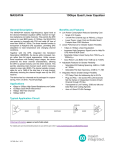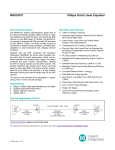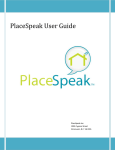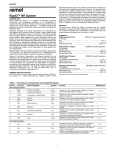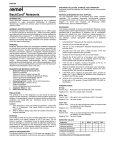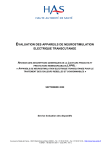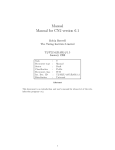Download QI 4 Research Ethics Surveys: A User's Guide
Transcript
QI 4 Research Ethics Surveys: A User’s Guide The Three Surveys Three types of surveys are posted on this website: 1. Survey for Research Participants 2. Survey for Researchers 3. Survey for REB Chairs, Administrators, and Members Aim of the Research Ethics Surveys The three types of surveys included on this website (researchethicssurvey.ca) are intended as quality improvement (QI) tools for human research protection. The tools are easy to use and can be modified for each user’s particular needs. They are designed for gathering information that will promote better communication amongst and between researchers, research administrators, research participants (research subjects) and research ethics committees (REBs, IRBs, RECs, etc.). All too often in human research protection, key parties work in relative isolation. Research participants may not be aware of avenues (if available) to provide feedback to researchers and research ethics committee members, and sense their voices are not heard. Researchers may feel distant from the research ethics committees that oversee their research. Research ethics committee members may feel that their institutions do not understand their concerns. These survey tools are intended to help close these gaps in understanding by providing snapshots of key respondents’ observations and concerns. Our hope is that the process of conducting the surveys and the information gathered through these surveys will provide a starting point for increasing mutual understanding amongst key parties in health research involving humans. With suitable modifications, we believe that these surveys can be used in other types of research as well. 1 Emphasis on Quality Improvement These surveys are meant to be part of a quality improvement process instituted by various parties involved in health research. The surveys are intended to initiate and sustain a helpful learning process on the part of survey users. The surveys are NOT intended for quality assurance or compliance purposes. Use of the surveys for these purposes is likely to provoke negative reactions and inhibit rather than enhance communication and understanding. There are other tools better suited to compliance and assurance purposes. The surveys are NOT intended for quality assurance or compliance purposes. The surveys should be part of a larger process of meaningful engagement and not treated as a substitute for that process. Thus, it is important to follow up on the results of surveys with meaningful dialogue. The survey should be the start of a dialogue and not its conclusion. To this end, we strongly urge providing at least a summary of survey results to respondents. To maximize the benefits from these surveys over time, we suggest repeating them every couple of years in order to get a sense of trends over time and as a way of determining whether specific QI initiatives have been achieving their desired effects. Acknowledgement These surveys and accompanying materials are posted for public use. There is no expectation that the data collected from them will be shared with the authors of this website. However, when you use one the surveys, please acknowledge the source of the survey with a link to this website (QI4 Research Ethics Surveys, researchethicssurvey.ca). Your Feedback is Welcome We would like to know about your use of the surveys and receive any comments you may have about them. Moreover, users who create new versions of the surveys, including versions to address special needs and contexts, are both invited and encouraged to send these to us for posting on the site so that others may use and benefit from them. Please indicate if you wish to have your name and affiliation attached to your comments and revisions. 2 Who Should Use the Surveys Individual Researchers Either during or after research, researchers could use the Research Participant Survey to get a better understanding of the experiences of participants in their research. This could lead to improved interaction with those participants or participants in future research projects. The Research Participant Survey can be a proactive way for researchers to reach out to participants and signal that researchers want and value participants’ feedback. Research Ethics Committees A research ethics committee might want to employ the Researcher Survey to hear from researchers. This could identify areas for dialogue with researchers and improvement in REB activities. The research ethics committee working in concert with researchers could also use the Research Participant Survey to find out more about the perspectives of participants in projects they have previously approved. The results could then be used to inform and improve their deliberations on research proposals in the future. Research Administrators & Research Institutions A research administrator could use the REB Chairs, Administrators, and Members Survey to receive candid feedback from ethics committee members and thus contribute to sustained dialogue between the administration and human research protection services. A research institution in cooperation with researchers and its REBs could use all three surveys to get an overall sense of areas for potential improvement across the broad range of human research protection. Surveys might, for example, indicate areas in which there was over-protection as well as areas in which there was underprotection. We recognize that not all REBs are based in institutions but provide their services to various clients or stakeholders such as pharmaceutical organizations, contract research organizations, medical clinics or community groups. In this case, the surveys can and should be adapted for these and other special circumstances. In addition, questions concerning TCPS2 would need to be removed or modified if the surveys were employed in the province of Québec or outside Canada. For Those Conducting Research on Research Ethics The surveys could be helpful in conducting research on human research protection. For Canadian institutions and researchers receiving support from the Tri-Council (CIHR, NSERC and SSHRC), such research would require approval from the appropriate research ethics board. 3 Moving From a Reactive to a Proactive Stance in Research Ethics Currently in research ethics review, most institutions, researchers and REBs act in a reactive rather than proactive manner. Changes in standard practices are only reconsidered when complaints are received. The assumption is that if everyone is quiet, then they must be satisfied with the status quo. However, such a reactive stance does not take account of those who are too timid or shy to complain (e.g., participants from disadvantaged groups who cannot communicate well in English or French), those who think no one will listen to their opinions (e.g., researchers who are unhappy with current practices in ethics review) or those who are discontented but too busy to complain. Moreover, a complaints-based process misses the good ideas that would improve satisfaction with human research protection arrangements, reduce costs and improve efficiencies. Imagine, if you will, a company or government that relies solely on complaints as an indication of customer or voter satisfaction rather than actively seeking and engaging key stakeholders. It is highly likely that such an organisation will fail over the long run or at the least find that it misses important opportunities and fails to anticipate likely threats. Reaching out to key constituencies allows one to act in a more evidence-based way. It also indicates that one is open to communication with key stakeholders. Using the Surveys Prior to using any of these surveys, it is important to explain to potential respondents: Who you are and in what capacity you are acting (e.g., as a researcher, REB chair, or research administrator) Your purpose in using the survey What protections there are for the respondents’ privacy o We suggest delinking the survey results from IP addresses and other potential forms of identifying information. o We also suggest using Fluid Surveys to ensure the data is protected according to widely accepted Canadian norms. FluidSurveys is a Canadian company based out of Ottawa, Ontario used by a wide range of Canadian universities including: University of British Columbia, University of Ottawa, McGill University, Carleton University, University of Alberta, and Douglas College. This survey provider describes itself as a Canadian alternative to SurveyMonkey and assures customers that “FluidSurveys is compliant with Canadian privacy (all data resides on Canadian servers) and accessibility standards (W3C).” 1 That the survey will be used for quality improvement purposes only and not for compliance or assurance purposes 1 See their website: http://fluidsurveys.com/alternative/to-surveymonkey-canadian 4 In some situations, you may want to use an abbreviated part of the survey by targeting the items that you most need answered. In other cases you may want to add questions that cover the particular context of your research setting. In such cases we recommend pilot testing the survey before distributing it widely. It is important to use a dependable survey platform that produces good quantitative and qualitative information. We used FluidSurveys in testing and were quite pleased with the ease of use. FluidSurveys also automatically compiles and analyses survey data and generates reports and PowerPoint slide decks. Please let us know if you have worked with another online platform that performs equally well and we will add it to this section of the user’s guide. Research Ethics Approval and the Surveys For Canadian institutions operating under the Second Edition of the Tri-Council Policy Statement: Ethical Conduct for Research Involving Humans (TCPS2) (http://www.pre.ethics.gc.ca/eng/policy-politique/initiatives/tcps2eptc2/Default/) the use of surveys for quality improvements should bear in mind Article 2.5: Article 2.5 Quality assurance and quality improvement studies, program evaluation activities, and performance reviews, or testing within normal educational requirements when used exclusively for assessment, management or improvement purposes, do not constitute research for the purposes of this Policy, and do not fall within the scope of REB review. (http://www.pre.ethics.gc.ca/eng/policy-politique/initiatives/tcps2eptc2/chapter2-chapitre2/#toc02-1a) For an informative discussion of issues involved in determining whether projects need ethics review or not and useful tools in this regard, see the website for the Alberta Research Ethics Community Consensus Initiative (http://www.aihealthsolutions.ca/arecci/). Even though quality improvement studies normally fall outside the scope of REB scrutiny, it is important to reflect carefully on the ethical implications of conducting such studies including: Privacy and confidentiality of respondents Protection of vulnerable individuals Recognition of the limits of the data acquired Potential effects on the reputation of individuals and institutions Maintaining good working relations with colleagues Concern for the public good 5 Moreover, for the Research Participant Survey it would be respectful to seek specific consent from participants to re-contact them for quality improvement purposes. There may also be circumstances where REB approval is necessary, e.g., when using the survey tools to conduct research on human research protection. Those who use the surveys should also ensure that they have acquired the necessary institutional approvals and are adhering to the relevant policies and procedures of their organization. Your Input is Welcome As mentioned previously, we welcome suggestions for improving the surveys or modifying them for special situations. We also welcome comments about your experiences in administering, interpreting, or using the results of the surveys. We are using an edited commentary process to improve and refine the surveys. The site’s Webmaster, Dr. Michael McDonald, is happy to receive your comments on the surveys and their use. He will select and post comments that seem helpful to the process for others to view. In communications, please let Dr. McDonald know if you intend your comments for posting and if you want to be identified by name. Hints for Modifying the Surveys In constructing the surveys, we found that we had to actively resist the temptation to keep adding more questions. Remember that your respondents are less likely to complete longer surveys. In our tests we aimed at surveys that could easily be answered in roughly twenty minutes. So when modifying the survey, you might want to subtract a question for every question you add. We also tried to use questions with Likert-type scales and Yes/No options to produce quantifiable data that could be analysed quickly with larger samples. But it is also important to leave room for qualitative input. Your respondents may want to tell you something important that you did not anticipate or that cannot be captured in pre-set quantitative question formats. Interpreting the Surveys These surveys are about perceptions. They provide a means for survey participants to provide their feedback. Not all participants will agree with each other and some participants may seem better informed than others. In some cases, even well informed participants may disagree about their perceptions because they are experiencing and interpreting the situation from different perspectives. It is important then, when analysing survey results, not to become obsessed with determining “who has the correct perspective?” The objective with these surveys is to learn from the diversity of perspectives. 6 As already noted, the surveys should not be used for compliance or assurance purposes. They are intended to be employed as one step in the process of communication and quality improvement. Creating & Testing the Surveys The initial draft surveys were created in the summer of 2011 at a meeting in Montréal. The surveys were further refined by the UBC team at the W. Maurice Young Centre for Applied Ethics (McDonald, Longstaff, and Preto) and sent back to the rest of the group. The surveys have gone through two rounds of testing. In the first round of testing, the surveys were evaluated for comprehensibility and completeness by groups of research participants, researchers, and REB members who resemble those who would ultimately use the survey tool (n=up to 30 total testers in each group). There was also a focus group held with a subset of research participants (n=6). This led to further refinements of the surveys. In the second round of testing, the revised surveys and explanatory information were sent to experienced professionals working in research ethics for further comment and suggestion. We are grateful to all who participated in this process. Some of the recommendations offered by focus group and other participants are shown below for new users to consider when developing alternative versions of the surveys. Feedback from focus group with participants It might be helpful to distribute this survey immediately after the research study in question is complete while participant experiences are still fresh. Participants appreciate researchers who include an “other” category in a gender demographic question. And when asking about occupation, researchers should include categories like: student, stay at home parents/work from home, and self-employed. If asking about health status, the researchers should include categories for mental illness and recovering from illness or temporary conditions (such as pregnancy). Consider providing incentives that would encourage participants to complete these surveys. It was noted that although monetary incentives are nice, participants might also appreciate incentives like planting a tree, or a donation to a charity in their name. Consider a short form (a few key questions) and long form of the survey (for those who are really interested). The survey tool should be modified to reflect duration of research and type of research. For example, those who just did a quick psychology survey should have different questions than those who participated in clinical trials. 7 If your study had significant changes, using this survey would be one way of confirming if participants were made aware of these changes appropriately and whether they received new information and consent forms where required. For people who had a negative experience as a research participant, it is important to include a 1-800 toll-free number to the appropriate REB participant protection hotline or complaints line and an email address at the end of these materials that they could use to bring their concerns to the research ethics board. Feedback from REB members and researchers If your REB reviews both physician-initiated and industry-sponsored research, you may consider posing questions that address each category separately. To get clearer responses, you might consider asking people to think only about their last application to the REB or their most problematic application. It might be useful to ask participants to identify barriers for educational and training opportunities so that these issues can be addressed. You might want to ask questions about the type of board and the volume of protocols reviewed by the REB and if pre-reviews are conducted. Consider adding comment boxes for particular questions that are of specific interest to your group. You may want to include questions about who was involved in the recruitment process and the language used in the materials. Consider asking additional questions regarding consistency of REB responses for topics such as single multi-site trials and research over many years. It may be important to add additional questions about how the REB handles conflicts of interest. Scope of the Surveys The surveys are suitable for the broad range of methodologies currently used in several types of health research. These include various types of clinical research (including clinical and medical device trials), survey and interview research, and research involving health data. They can be used in a wide variety of settings – academic institutions, health science centres, clinical institutions, public health institutions and private sector health research. The surveys are also readily adaptable for research involving humans in areas outside health. These surveys were prepared with the Canadian context (TCPS2 http://www.pre.ethics.gc.ca/pdf/eng/tcps2/TCPS_2_FINAL_Web.pdf) in view. However, we hope that the surveys may prove of use outside of Canada as well. 8 Content of the Surveys As shown in the table below, the three surveys have a common structure covering the lifecycle of research. Survey Research Participants Researchers REB Members Introduction Consent Form or Letter of Invitation Consent Form or Letter of Invitation Consent Form or Letter of Invitation Section 1 Questions Before the research begins Becoming aware of the study Reasons for participating Receiving information about the study Demographic Questions Demographic Questions Section 2 Questions During the research Interactions with research team members Experiencing changes in the research design and process Responses to changes Continued participation/ withdrawal Researcher interactions with REB Opinions about the ethics review process Rating REB responses to proposals Ethics training Interactions with REBs Availability of education and ethics resources Submissions to your REB Quality of submissions Factors that delay approval Section 3 Questions After the research Receiving research results Rating the experience Level of satisfaction Treatment as a research participant Survey evaluation Opinions about human research participants Availability of QI tools for working with participants Participant motivations for participating Receiving feedback from participants Perceptions of participants’ experiences Section 4 Demographic Questions REB processes and training Time allocation for review process Institutional support for REB training and education Interactions with researchers Estimation of risk to participants Assessment of REB’s roles Recognition and support Feedback from researchers and participants Evaluation Rating this survey Section 5 Evaluation Rating this survey Evaluation Rating this survey 9 About Us These surveys were created by several members of the “Canadian Network for the Governance of Ethical Health Research: Evidence, Accountability, and Practice” (the Governance Network). The Governance Network has been supported by a grant from the Canadian Institutes for Health Research (CIHR). Over the years, the Governance Network and its earlier predecessor have produced three special issues of the Health Law Review: 2005, 2009 and 2011 as well as other publications. We are grateful to the support CIHR has provided for this and other research projects on human research protection over the past several years. The following Governance Network members were part of the Montréal meeting in summer, 2011 at which the surveys were conceived. They also provided further input to the questionnaires as the process went along. Dr. Michael McDonald, Professor Emeritus of Applied Ethics, W. Maurice Young Centre for Applied Ethics, University of British Columbia, & PI for the Canadian Network of Ethical Health Research Dr. James Anderson, Research Associate, National Core for Neuroethics, University of British Columbia Dr. Susan Cox, Associate Professor, W. Maurice Young Centre for Applied Ethics, University of British Columbia Pierre Deschamps, Associate Director of Research (Law and Health Section), Research Centre in Private and Comparative Law, and Adjunct Professor, Faculty of Law, McGill University Dr. Michael Owen, Associate Provost Research, University of Ontario Institute of Technology Dr. Daryl Pullman, Professor of Medical Ethics, Memorial University of Newfoundland Dr. Raphael Saginur, Chief, Division of Infectious Diseases, Ottawa Hospital – Civic Campus, Ottawa, ON Dr. Donald J. Willison, Senior Scientist, Surveillance & Epidemiology Division of the Public Health Ontario, Toronto Heather Sampson, Manager of Research, Joint Centre for Bioethics, University of Toronto The process was then furthered by: Dr. Holly Longstaff, Research Associate, W. Maurice Young Centre for Applied Ethics, University of British Columbia and Engage Associates Consulting Group Dr. Michael McDonald, Professor Emeritus of Applied Ethics, W. Maurice Young Centre for Applied Ethics, University of British Columbia, & PI of the Governance Network Nina Preto, Governance Network Member, Doctoral Candidate, W. Maurice Young Centre for Applied Ethics, University of British Columbia and Engage Associates Consulting Group 10










